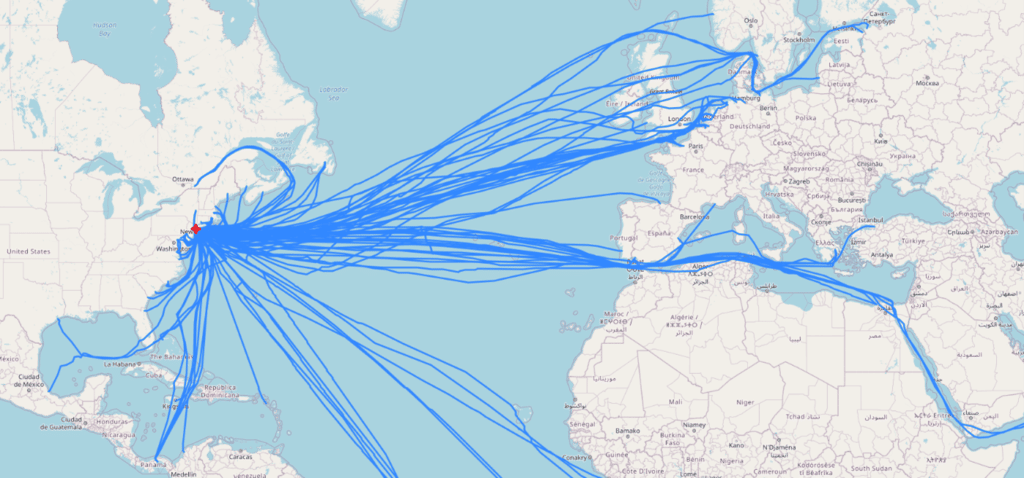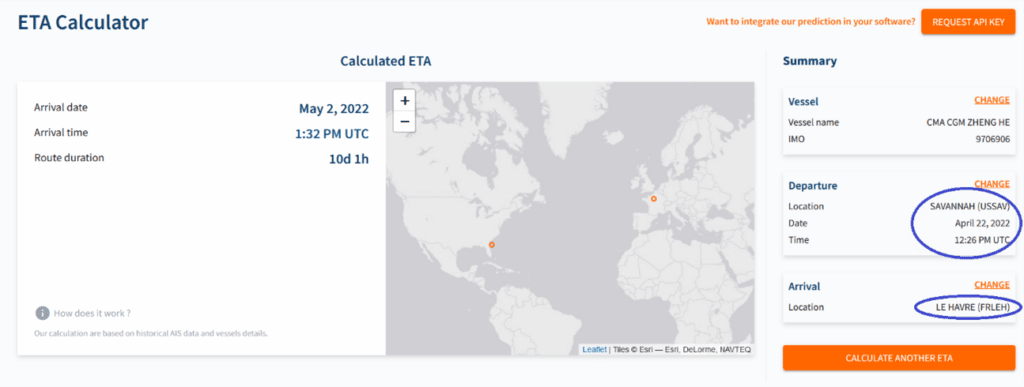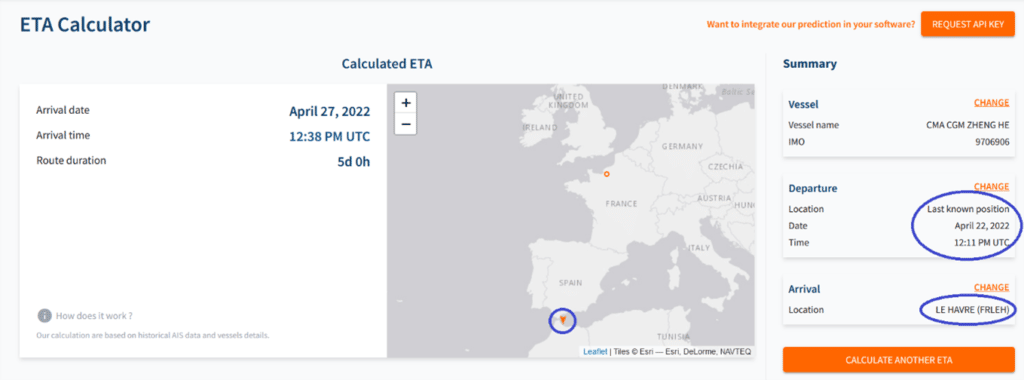Because of the globally increasing demand for cargo shipping and recent major crisis, the shipping industry is under pressure: congestions have become the norm in many major ports which can experience delays of several weeks. Planning accurate hours of arrival and departure for vessels is a difficult task, subject to many out-of-control factors: weather, port congestion, tides…
This article will go over how we predict a time of arrival for cargos and tankers and how the Sinay ETA Module can help you to plan your shipping more accurately.
ETA, ETD, ATA and ATD
Specific terms are used in the maritime industry to describe the arrival or departure of a vessel and each corresponds to a precise step of the port planning process.
Estimated Time of Arrival (ETA) is when a ship or vessel is expected to arrive at a specific destination. This information is usually transmitted through the Automatic Identification System (AIS) by the captain of the vessel.
Estimated Time of Departure (ETD) is when a ship or vessel is expected to depart.
Actual Time of Arrival (ATA) is when a ship or vessel actually arrives at the destination port
Actual Time of Departure (ATD) is when a ship or vessel actually leaves the departure port
Our goal is to provide a precise Predicted Time of Arrival (PTA) to help the captains, shipping companies and ports better plan the maritime traffic and avoid congestion. It is supposed to be better than the ETA and its quality is assessed using the difference with the ATA. For more information, check our article on the Meaning of ETA, ETD, ATD & ATA in Shipping.
Why is it challenging to estimate a time of arrival?
During its voyage, a vessel may encounter a wide range of events that can change its planned course and/or time of arrival (Figure 1). This may include a strong weather, a change of speed or a congested maritime traffic line. When approaching a port, the vessel may be required to wait for its turn in a dedicated zone for an undetermined time that can range from one hour to a few days. Once the port is ready to welcome it, a pilot boarding or tug vessel may be required to enter the port and access the berth. Once docked, the unloading process duration will depend on the available equipment and the port crew planning. Furthermore, the vessel entry may be conditioned by its draught because it must be compatible with the bathymetry of the port: in some areas, the tides need to be considered to make way for a vessel, which can cause additional delay.

A lot of steps need to happen between the time of arrival at/near the port (or in waiting zone) and the vessel departure from the port and it is not easy to evaluate the duration for most of them. For these reasons, one must be specific when providing an ATA: is it the ATA to the waiting zones or the ATA at berth? Sinay ETA Calculator provides a PTA to the waiting zones, or near the port if there is none (~5 nautical miles).
How do we know where the waiting zones are?
Computing a PTA to the waiting zones is easier than computing a PTA at berth, but we still need to know when a vessel has entered the waiting zone. To detect these zones, we perform the following steps for each port:
- After sorting the AIS messages by vessel identifier to obtain trajectories, we detect when a vessel has stopped near a port and cut the trajectory there to get a track from one port to another. Practically, we look for AIS messages with a speed close to zero within range of the port.
- This set of tracks is then processed with an algorithm that cut it into moving (green on figure 1) and stopped (red on Figure 2) segments. This will be useful to detect groups of vessels waiting outside the port.
- The stopped observations are then filtered to only keep the waiting zones candidates, i.e. the ones close to the port with a compatible bathymetry.
- Thanks to a clustering algorithm, we detect groups of stopped position to generate areas. These are the waiting zones of the port (small blue polygon on Figure 2).
- Some ports do not have waiting zones: we thus draw a circle with a radius of 5-10 nautical miles around the port and consider it as the arrival zone. This circle is then merged with the waiting zones (if there is any) to form an arrival polygon (large blue polygon including the port on Figure 2).

How are maritime routes generated?
To evaluate the remaining travel time better for a vessel, the most direct way is to extract the main maritime routes to know where the vessel is likely to navigate, and, therefore, the traveled distance. Let explain how they are generated.
If a vessel stops in a waiting zone, we cut the track there to get the time of arrival in the waiting zone (Figure 4). If a track does not stop in a waiting zone, we cut it at the first position entering the arrival zone to ensure that all tracks are cut approximately at the same distance from the port (Figure 3). This is important because waiting zones can be up to 50 nautical miles away from the port (e.g. Hamburg, Germany (DEHAM)).




These routes are then used to determine the remaining distance between two ports or between a vessel position and a port.
How is our Predicted Time of Arrival computed?
We can compute a PTA from any point to a port of destination. As previously said, we consider a vessel as arrived when it reaches the pilot boarding area or a waiting zone (which usually are the same) or, if it doesn’t stop, when it enters the arrival polygon (Figure 7, Figure 8).


To compute PTA, we use two different models: a statistical one and a machine learning one. These models have been chosen according to their relative performances in the different use cases: we choose the best-fitted one for each situation.
A statistical model
How – It is composed of statistics computed on one year of historical routes
Usage – This model is well fitted and used to compute PTA:
- for vessels that are still in a port of departure
- for planning (future date of departure)
Note that this model does not take real time information into account. But in these two cases, real-time information is not required. In our ETA Calculator (Figure 9), we use that model when the departure point is set as a specific port.

A machine learning model
How – It is a real-time model that « learns » travel characteristics on one year of historical routes. As opposed to the statistical model, it takes real-time parameters into account.
Usage – This model is well fitted and used to compute PTA:
- for vessels that are in open sea / that are already in travel
In that case, our ETA Calculator (Figure 10) uses the AIS messages to compute PTA that will consider parameters such as the size of the vessel, its draught, its current speed, etc.

To know more about how machine learning can be used to compute a PTA, read our article on ETA and Artificial Intelligence.
What are the available ports?
We currently have 33.810 different routes covering 1195 destination ports and 3.195 departure ports. Do not hesitate to ask for our accurate coverage map.
Frequently Asked Questions About: ETA Calculator
Estimated and actual times of arrival and departure are extremely important to the maritime industry and supply chains.
Types of shipping include: bulk carriers to transport grain, ore, wood ships and other materials/products down into a hold, general cargo ships who carry loose-packaged cargo, consisting of goods, unpacked or packed, cargo container ships, tankers, and roro ships.
Estimated time of arrival (ETA) in shipping is the estimated time the ship will arrive at anchorage (waiting outside the port) or at the dock. The estimated time of departure (ETD) is when the ship is estimated to leave the dock.
